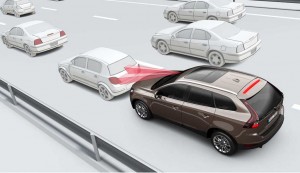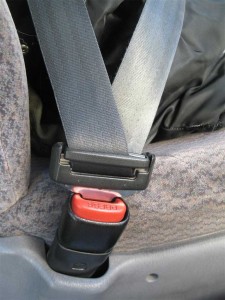
Volvo's City Safety system can bring a car to a halt to avoid an accident. But are motorists willing to pay for advanced technology like this?
Despite the loss of more than 40,000 lives on U.S. roadways, each year, Tier One suppliers are finding it’s a hard sell to get their newest technology out onto the road. They hope the government can help, less with money than with legislation.
A variety of safety systems are available to keep drivers alert by making objects more clearly visible, especially at night; warning drivers of danger; waking them up, if necessary, and even hitting the brakes when drivers don’t. While all of these systems have the potential to reduce fatalities, relatively few are in use, and most of those that are appear on high-line luxury vehicles, such as the BMW 7-Series or Mercedes-Benz S-Class.
In the U.S. market, suppliers are hoping that the National Highway Traffic Safety Administration (NHTSA) will help stimulate sales when the agency revises its NCAP (New Car Assessment Program) standards.
Delphi, partnering with chip maker Mobileye, sold a radar and vision system to Volvo for S60 models, which is due to market next year. The multi-faceted system, which includes a high-profile concept called “City Safety,” provides full speed range adaptive cruise control, which means that the Volvo automatically slows down when the car ahead slows down, and if a full stop is warranted the car will do it if the driver doesn’t. Adaptive cruise control can reduce the number of rear-end collisions that occur each year, but few vehicles are equipped with the technology.

The most effective safety device on the road is still one of the cheapest, the seatbelt. But new technology is spreading across the automotive world. The question is how much are consumers willing to pay for radar and video-based technology?
Hella and other suppliers have developed lane departure warning systems that nudge the driver if the vehicle veers outside its lane markers unintentionally, whether from the driver drifting off momentarily or making eye contact with a passenger. Opel selected the Hella system for deployment on the Insignia in Europe, where speed limits are higher and drivers are generally more aware of the value of safety technology compared with their U.S. counterparts.
Continental recently announced that Mercedes will deploy Continental’s camera-based adaptive high-beam assist system on E-Class vehicles. It can detect an oncoming vehicle or a vehicle in front and adjust the range of the vehicle’s headlights accordingly, automatically. Continental says its technology effectively increases the range of low-beam lights from about 65 meters to nearer 300, but without blinding other drivers.
Camera and/or radar technology is available to recognize and respond to objects, whether speed limit or other highway signs, or pedestrians in the crosswalk. Blind spot detection and side alert systems help drivers see what they might otherwise miss in adjacent lanes. And while those systems are increasingly common on high-end vehicles, they have yet to reach mass markets.
Automakers have long argued that “safety doesn’t sell.” And despite the high profile given the latest breakthroughs, as well as the headlines that accompany the annual reports on government and insurance industry crash tests, the reality is that this still seems true.
Safety systems, lumped together in a category called ADAS (advanced driver assistance systems), have potential for differentiating a vehicle from its competition – or they would if safety were more sexy. Suppliers say it’s not clear which features will have the greatest appeal, and since few features are available, consumers aren’t familiar with them.
Cost is obviously a factor but suppliers can’t benefit from high volume sales of safety systems, so they are working with component suppliers to increase quality – sharper images and more processing horsepower, for example – and to combine multiple applications in one system to reduce cost and conserve windshield space.
“Lane departure warning continues to lead current applications, but we expect additional interest in medium-range forward collision warning applications due to recent NHTSA (National Highway Traffic Safety Administration) focus on active safety technologies in their NCAP (New Car Assessment Program) standards,” says Bill Shogren, chief engineer of advanced safety systems at Delphi Electronics & Safety division. “Pedestrian and traffic sign recognition are also gaining interest.”
“There is no mandatory requirement for vision technology. The moment that comes, it will be just a matter of time before vision technology will be as prevalent as AM/FM,” adds Sandeep Kishore, senior vice president at HCL Technologies.
NHTSA is currently working toward legislation related to rear-view technology, which has the potential to reduce backover fatalities.
“We’re seeing a focus on advanced cockpit electronic products to enhance the driving experience,” says Tim Tiernan, senior manager of advanced cockpit electronics at Visteon. “This can help make drivers better drivers and improve the value proposition for our customers and consumers. There is also a focus on evolving rear-view cameras from view-only products to ‘smart.’ or image-processed systems.”
Robert Bosch supplies night vision systems for Mercedes vehicles. Infrared (IR) high-beam headlights illuminate an area of more than 150 meters in front of the vehicle. The beam is invisible to the human eye, so it does not blind oncoming traffic. A video camera converts the incoming IR signal to an image that the driver can see.
Bosch is working on Night Vision Plus, which will be able to recognize whether pedestrians in the displayed image are standing or moving. It will highlight pedestrians or bicycles in color to make them more visible, and it will be able to recognize and call a driver’s attention to road signs.
“If the driver is not sure what is 100 or 120 meters in front of them, he or she can glance down for a couple of seconds and then go back to normal driving behavior,” says Dieter Hoetzer, Bosch’s product manager for automotive radar and camera products. “It’s an additional HMI (human-machine interface), but it’s not a distraction.”
Hoetzer and others say that European automakers are pushing vision technology more aggressively than their counterparts in North America. “Lane departure warning and forward collision warning are more in the eye of American OEMs,” he notes.
“NHTSA is expected to come out with a new NCAP five-star rating that will give specific language to new technology,” Hoetzer says, “but we’re seeing a lot of push toward low-cost applications – reduced functionalities with low-cost hardware, such as a standalone sensor with all functions in one box in the front of the vehicle.”
There seem to be growing differences, if anything, in what different markets want from their safety systems.
“North America is focused on NHTSA NCAP compliance and rearward visibility applications, while Europe looks for adaptive headlight control and traffic sign recognition features on top of a base of LDW,” adds Delphi’s Shogren. “Asian countries are focused on ‘around view’ systems that apply to more congested environments, and there is sporadic interest in China toward status symbol type features.”
Shogren adds that automotive camera costs are coming down as more systems move into production. “Camera components are beginning to become a commodity.”
“Camera-based systems are semiconductor-based and therefore subject to ongoing cost reductions,” said Inayat Khajasha senior automotive product marketing manager at OmniVision. “As technologies improve and manufacturing processes mature, camera system costs can be reduced while performance and capabilities improve.”
Perhaps lower costs and a push from NHTSA will stimulate the market – and start saving lives.
